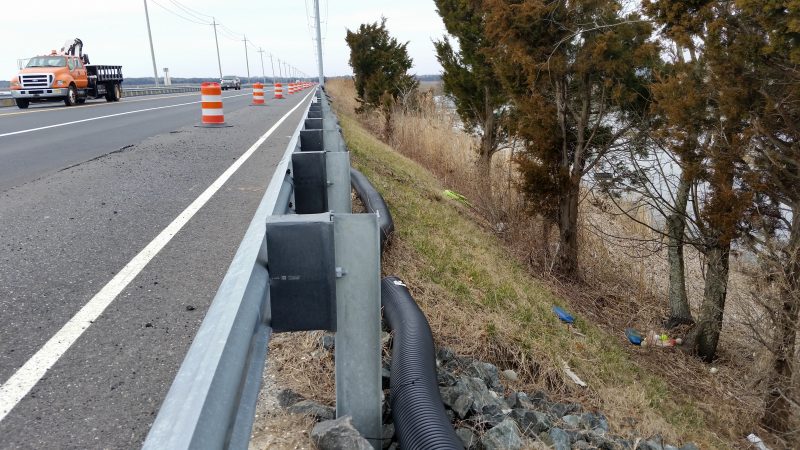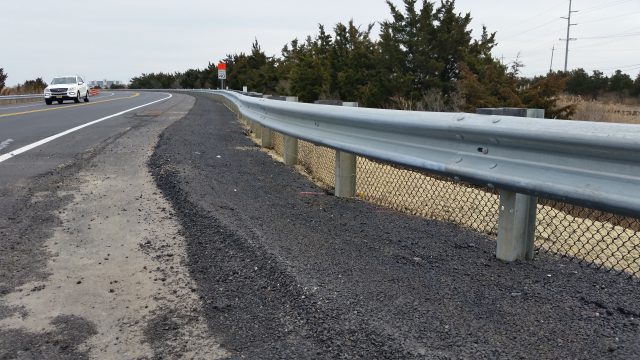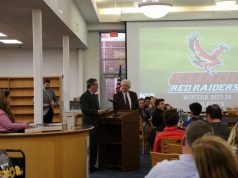By Donald Wittkowski
Why did the turtle cross the road?
What may sound like the opening line of a corny joke actually raises a serious issue at the Jersey Shore.
Each summer, legions of diamondback terrapins emerge from the marshlands in search of dry sand or soil in which to lay their eggs. This ritual often sees them cross over local roads – frequently with deadly consequences.
Their lumbering pace leaves them vulnerable to cars or trucks running over them, so engineers are devising ways to stop the turtles from venturing out on the roads in the first place.
On the newly rebuilt Sea Isle Boulevard, construction crews are installing metal fencing under the guiderails that will act as a turtle barrier.
“The fencing that is being installed along the backside of the new guiderail of Sea Isle Boulevard is ‘Turtle Exclusion Fencing’ and consists of a black poly coated chain link fence material. The purpose of the fence is as its name implies, to exclude diamondback turtles from entering the roadway,” explained Cape May County Engineer Robert Church in an email.

Church noted that the fencing will make the boulevard safer for both the turtles and the humans who travel the road.
“This lowers turtle mortality rates and lessens the likelihood of vehicular accidents resulting from swerving to avoid turtles or running over the turtles,” he said.
The fencing is already in place along the side of the boulevard’s inbound lane entering Sea Isle City. It will also be installed on the side of the outbound lane, replacing plastic tubing that has served as a temporary turtle barrier.
Steve Ahern, who, along with his wife, Susan, runs the Sea Isle Terrapin Rescue organization, believes the metal fencing will be far more effective in keeping the turtles off the road than the plastic tubing, which has gaps in places, allowing turtles to crawl through it and onto the boulevard.
“I think that stuff is fantastic. When we’ve seen it used in other places, it seems to work well,” Ahern said of the fencing.
Ahern said turtles have been saved by metal fencing running along both sides of the road through the marshlands in Corson’s Inlet between Ocean City and Strathmere. A chain link fence on the bay side of the Ocean Drive in Avalon has been another effective turtle barrier, he added.

The metal fencing on Sea Isle Boulevard was required by the New Jersey Department of Environmental Protection as part of the regulatory permits issued for the county road’s $12.7 million reconstruction project. Both sides of the boulevard have been raised by 4.5 feet to protect it from flooding during coastal storms.
“During the design of the project and as part of the environmental permitting process, the presence of a significant diamondback turtle population was identified, and consequently the protection of these turtles from vehicular traffic was incorporated as a condition of the environmental permits,” Church said. “One of the many conditions that the NJDEP required to allow the project to move forward was to provide Turtle Exclusion Fencing along the roadway.”
When completed, approximately 19,417 linear feet of fencing will have been installed at a cost of $194,170, Church said.
Ahern praised the county for recognizing the importance of diamondback terrapins to the shore’s eco-system.
“They always had a big concern for the plight of the terrapins,” he said.

Diamondback terrapins can live for 30 to 40 years, a remarkably long time for these denizens of New Jersey’s coastal salt marshes that are constantly threatened by predators and highway hazards.
The females often suffer a cruel fate when they try to cross the roadways to lay their eggs in the beaches, sandy soil or dirt. Their small shells are no match for scores of cars and trucks traveling to Sea Isle and other beachfront vacation communities.
Tragically, the only time many people see the turtles at the Jersey Shore is when they lie crushed along roadways crowded with summer tourist traffic.
According to a NJDEP press release, diamondback terrapins once were abundant, but their population decreased dramatically by the 1930s, due primarily to harvesting for food. Their numbers started increasing by the 1960s, but in recent decades the diamondbacks have been at risk again due to habitat loss, drowning in crab traps and being run over by cars, the NJDEP says.
Although the diamondback terrapin has not been listed as threatened or endangered in New Jersey, its status is listed as decreasing. As part of the state’s recovery effort, former Gov. Chris Christie signed legislation in 2016 that bans the harvesting of diamondback terrapins and prohibits disturbing their nests and eggs.

Ahern said the diamondbacks’ nesting season generally runs from late May or early June to late July.
On average, 70 to 90 turtles were killed each year on Sea Isle Boulevard before the plastic tubing was installed as a barrier in 2018, Ahern noted. The tubing helped keep turtles off the road, but the diamondbacks occasionally were able to crawl through gaps and make it onto the boulevard, which proved fatal.
The hope is that the number of turtle fatalities will be extremely low now that metal fencing is being placed on both sides of the nearly two-mile road connecting Sea Isle with Exit 17 of the Garden State Parkway.
But the fencing begs another key question: Where will the turtles go to lay their eggs if they can’t cross the road?
“They may be forced to find other places,” Ahern said. “That doesn’t always work out to be a good thing.”








